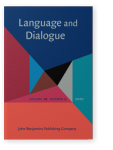Vol. 10:2 (2020) ► pp.194–214
Compliment responses in Icelandic
Compliment responses are speech acts assumed to mirror cultural appropriateness. In this sense, a review of responses to compliments offers cues about the ways in which speakers react to dialogic strategies of politeness. In order to examine how Icelanders react to compliments, an Elicitation Experiment (EE) was designed to evoke natural responses. It consisted in asking a group of 81 Icelandic informants (46 female, 35 male) to read tongue-twisters in Dutch and Spanish during a set of interviews. Informants were complimented based on their performance and their responses were recorded. Based on 162 exchange tokens, it is possible to conclude that not agreeing to compliments is the most common way of reacting to compliments in Iceland.
Article outline
- 1.Introduction
- 2.Literature review
- 3.Research questions and methodology
- 3.1Elicitation experiment
- 3.1.1Participants
- 3.1.2Instruments
- 3.1.3Data collection
- 3.1.4Data analysis
- 3.1Elicitation experiment
- 4.Results
- 5.Discussion
- 6.Conclusion
- Acknowledgements
- Notes
-
References
